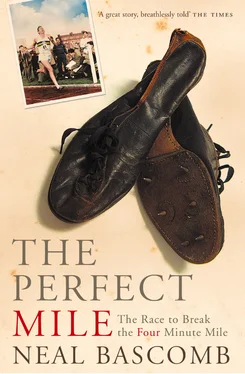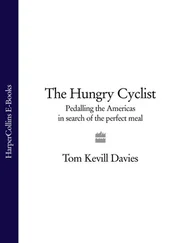To test himself against Cummings, George was forced to forfeit his amateur status, despite having offered his earnings from the races to a hospital charity. After a series of preliminary races where both had a share of the victories, on 23 August 1886 Cummings and George faced off for the ‘Mile of the Century’. Twenty-five thousand spectators crowded around a bicycle track to watch George run so fast that he left Cummings unconscious behind him on the last lap. His record of 4:12.8 lasted for three decades and set the stage for Paavo Nurmi to introduce the four-minute mile to the world, establishing an irresistible challenge to athletes that would guarantee their place in history.
It is impossible to know who first uttered the challenge of running the mile in less than four minutes. Reports date back to 1770 of an English runner who made the distance from Charter House Wall to Shoreditch Church in the City of London in this time, but even nineteenth-century historians raised a sceptical eye to the account. In 1915, when American Norman Taber broke George’s record by less than two-tenths of a second, the athletics world was not set on fire. It was too slim a difference to warrant much more than a passing remark in the record books. Then, on 23 August 1923, 26-year-old farm engineer Paavo Nurmi from Turku in Finland was drawn into a faster first lap than he would have liked by Swedish miler Edvin Wide. Nurmi, who always ran with a large stopwatch in his hand and preferred an even-paced race, kept up with Wide’s fast start. By the third lap Wide had faded, but Nurmi continued the pace. He broke Taber’s record by two seconds with a 4:10.4. It was a giant step forward, given how long it had taken Taber to reduce Walter George’s mark by just a fraction of a second. Suddenly the mile record was in play again, and when, at the 1924 Paris Olympics, Nurmi won gold medals in the 1,500m and 5,000m in the space of forty-two minutes, he looked capable of anything. Joseph Binks, a noted journalist and former British miler, suggested to Nurmi that the mile barrier was within grasp. Nurmi replied, ‘No. Four minutes four seconds, maybe!’ Self-deprecation or not, the Finnish miler had put the possibility of a four-minute mile on the table.
Inspired by Nurmi, a new wave of talented milers appeared in the 1930s, and their races packed stadiums around the world. Races at Madison Square Garden rivalled modern-day prize fights. The air was dense with smoke, the crowds rowdy and devoted to their favourite runners, and the stands so close to the track that fans felt the rush of air when the field surged past. The first miler to run four minutes and single digits was Frenchman Jules Ladoumegue. An orphan who first ran in village-to-village races, Ladoumegue competed on pure emotion. Before races he was so agitated that he had to be pulled to the starting line. If a door closed suddenly behind him, he nearly jumped out of his skin. Once running, though, he loved the heat of battle and became a national treasure for his efforts. On 4 October 1931 he took advantage of a windless, sunny Parisian afternoon and the pacemaking of half-miler Rene Morel to reduce the mile record to 4:09.2.
Jack Lovelock, the New Zealand-born but British-adopted miler with a compact frame and keen idea of his abilities and limitations, was the next to lower the record. In his youth he had developed his smooth running style by striding alongside a stone wall while a friend on the opposite side chastised him whenever he saw his head moving up or down. On 15 July 1933 in Princeton, New Jersey, he ran a 4:07.6 while representing Oxford University against the Americans. After the race, the New York Herald Tribune praised, ‘It was all so easily accomplished, with so little outward evidence of stress and strain, as to make a four-minute mile seem just around the corner.’ Lovelock never reduced this time, but his Olympic gold medal in the 1,500m, his epic races against Glenn Cunningham and Sydney Wooderson, and his insight about training and tactics added to his legacy.
With a time of 4:06.8, Lovelock’s rival, the American Glenn Cunningham, seized the mile record only eleven months after the New Zealander had claimed it. The ‘Kansas Powerhouse’ was legend long before he ran the fastest mile in the world. At the age of 7, he and his brother tried to stoke the fire in their small schoolhouse’s stove by dousing the coals with kerosene. His brother died as a result of the accident, and Glenn burned his legs almost beyond repair. During recovery he found walking more painful than running, and an athlete was born. Cunningham learned to work around his disability, and at his first inter-varsity mile at the University of Kansas, he exploded on the last lap to beat the field. His running inspired a generation of Kansas farm boys and gave Americans the hope that the four-minute mile could be theirs.
Sydney Wooderson brought the mile record back to England in 1937. Walter George, now 79 years old, was there to see it. At five feet six inches and 126lb, Wooderson was an atypical miler. When he stepped on to the track in his thick glasses and with the meek demeanour of a solicitor’s clerk, he looked the underdog. Once running, however, he was an indomitable force. He dealt with his loss to Lovelock at the 1936 Olympics by staging an attempt to beat Cunningham’s mile time. On 28 August 1937 at Motspur Park, he arranged for pacemakers from his athletic club to lead him around the first three laps. Using his famed kick, he handled the last lap alone and registered a time of 4:06.4.
Slowly, by investing more and more time and energy in training, milers approached the goal of four laps of the track in four minutes. But six and a half seconds was a long time off, and the small reductions made by the best runners to the record were just that, small reductions. The possibility of seeing ‘the other side’ of the numerical barrier was looking increasingly uncertain.
When Swedish runners Gundar Haegg and Arne Andersson finished their epic battles by the end of the Second World War, the four-minute mile appeared unattainable. Of the two, Haegg had a more natural, flowing stride, but Andersson trained harder. A year apart in age, they reached their peak at the same time. Separately, they were the finest milers, in terms of fitness and form, possibly ever to have graced the track; racing against each other, they looked to be the best that ever would. Over the course of three and a half years, Haegg and Andersson passed the mile record back and forth to each other:
| Date |
Runner |
Place |
Time |
| 1 January 1942 |
Haegg |
Gothenburg, Sweden |
4:06.2 |
| 7 October 1942 |
Andersson |
Stockholm, Sweden |
4:06.2 |
| 9 April 1942 |
Haegg |
Stockholm, Sweden |
4:04.6 |
| 1 January 1943 |
Andersson |
Gothenburg, Sweden |
4:02.6 |
| 18 July 1944 |
Andersson |
Malmö, Sweden |
4:01.6 |
| 17 July 1945 |
Haegg |
Malmö, Sweden |
4:01.4 |
Their duels inspired great performances, yet the barrier still stood untouched. Journalists and statisticians tried to convince the athletics world that the record would inevitably be run. They calculated that the average world-class miler could sustain a 7.33-yard-per-second speed (or 15mph). This meant that the difference between Haegg’s best time and the four-minute mile was a short twelve yards – less than 1 per cent of the race’s total distance. Nothing. But others disagreed, quite publicly as well. Coach Brutus Hamilton, one of the most revered figures in athletics, published ‘The Ultimate of Human Effort’, listing the perfect records for the javelin, shot-put, 100m, 400m, mile, 5,000m, and 10,000m beyond which man could never go. Hamilton backed up his analysis with detailed statistics, but many would have considered his word final had he simply jotted these ‘perfect records’ down on a cocktail napkin. Of the question ‘Can the mile be run in four minutes flat?’ Hamilton wrote, ‘Not quite.’ The fastest time that would ever be possible, he stated, was 4:01.6. Although Hamilton, who wrote the article in 1935, had by 1945 been disproved by two-tenths of a second, he still found the idea of anyone running faster difficult to imagine.
Читать дальше












